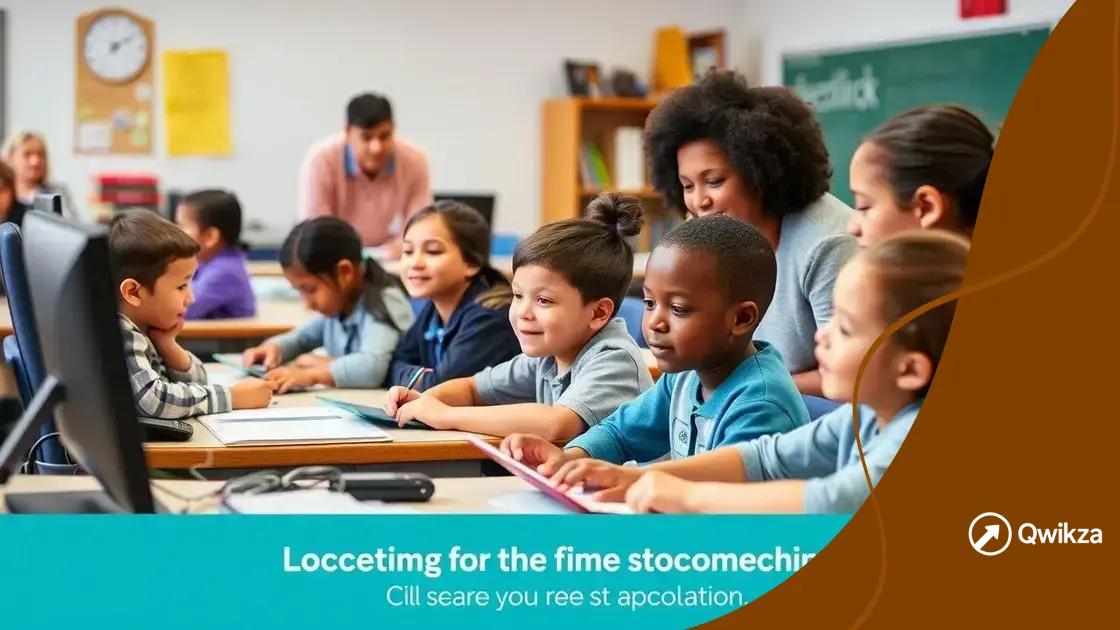Federal judge blocks Department of Education cuts

The federal judge blocks Department of Education cuts, ensuring stable funding for schools, allowing for improved educational resources and support for students nationwide.
Federal judge blocks Department of Education cuts, a ruling that could significantly impact educational programs across the country. Have you considered how these changes might affect students’ futures? Let’s explore the nuances of this decision.
Background on the Department of Education cuts
The recent decisions related to the Department of Education cuts have sparked significant discussion across the country. Understanding the background of these cuts is essential to grasp their implications for students and educators. In essence, these cuts were proposed as part of broader fiscal strategies to reallocate funds.
Reasons Behind the Cuts
The cuts stem from evolving government priorities and budget constraints. Educational programs faced reductions, impacting resources and support available to schools. It’s crucial to consider how these changes might affect quality education.
- Reallocation of federal funds to other initiatives.
- Focus on reducing the national deficit.
- Changes in policy affecting funding levels.
- Pressure from various stakeholders advocating for budget changes.
Furthermore, these measures intend to streamline operations within the Department of Education. This has raised concerns among educators and parents about maintaining well-funded programs. The potential loss of critical resources could affect various educational services, ranging from special education to after-school programs.
Impact on Educational Programs
The implications of funding cuts are significant. Programs aimed at assisting low-income students may face the greatest challenges. The concern is that these cuts can widen the gap in educational achievement. Schools that rely heavily on federal support may struggle to provide quality services.
- Reduced funding for vital learning programs.
- Challenges in hiring and retaining qualified teachers.
- Increased class sizes and fewer resources for students.
- Impact on extracurricular activities and support systems.
To combat these effects, schools and educators are seeking alternative funding sources. Advocacy groups are increasing their efforts to ensure students receive the educational support they deserve. Understanding this background helps us see the bigger picture of how funding decisions shape our education system.
Details of the federal judge’s ruling
The recent federal judge’s ruling against the Department of Education cuts has generated important discussions. This ruling is crucial as it directly affects funding for many educational programs nationwide. The judge emphasized that the proposed cuts could harm students’ educational opportunities, especially those in disadvantaged situations.
Key Aspects of the Ruling
In the ruling, the federal judge outlined several key points that are essential to understand. First, the judge highlighted the potential long-term consequences of the cuts. Second, the need for equitable education for all students was underscored. This ruling serves as a reminder of the legal responsibilities that education departments hold.
- Emphasis on the right to quality education.
- Concerns raised about the impact on marginalized communities.
- Legal precedent set for future funding decisions.
- Importance of maintaining critical educational programs.
The judge’s decision also included directives for the Department of Education to review their policies. This evaluation is important to ensure that future funding allocations do not disproportionately affect vulnerable student groups. As a result, schools can continue to receive the necessary support to provide adequate resources.
Public Reaction to the Ruling
The public reaction has been mixed but largely supportive of the judge’s decision. Many advocacy groups have praised the ruling for protecting vulnerable students. Educators are hopeful that this decision will lead to more secure funding in the future.
- Support from teachers’ unions and advocacy organizations.
- Calls for further reforms within the education system.
- Concerns about potential appeals from the government.
- Encouragement for ongoing dialogue about educational equity.
The ruling not only affects current funding but may also influence future educational policies. Schools and districts are closely monitoring the situation to understand how it may evolve moving forward.
Implications for students and schools

The implications for students and schools following the federal judge’s ruling are profound. With the cuts blocked, educational institutions can now focus on providing better resources and opportunities. This ruling reassures students that their access to quality education remains a priority.
Positive Outcomes for Students
One of the most significant benefits of the ruling is the stability it brings to students. As schools receive secure funding, students can expect to enjoy more comprehensive educational experiences. This can lead to improved academic performance and overall well-being.
- Access to essential programs such as tutoring and counseling.
- Reduced class sizes, fostering personalized learning.
- Increased availability of extracurricular activities.
- Better resources for special education services.
Furthermore, students will likely feel more supported in their educational journeys. A stable funding environment allows schools to invest in modern educational tools and technology, making learning more engaging and effective.
Impact on Schools and Staff
For schools, the implications are just as significant. With funding concerns addressed, schools can plan strategically for the future. This stability encourages hiring qualified educators and retaining experienced staff, which is critical for student success.
- Improved teacher retention rates.
- Opportunity for professional development and training.
- Enhanced collaboration among staff and administration.
- Better maintenance of school facilities and resources.
Additionally, schools can collaborate more with community organizations to create programs that support students. These partnerships can enrich students’ educational experiences, ensuring they have access to a broad range of learning opportunities. Overall, the ruling creates a ripple effect, positively influencing the entire educational ecosystem.
Reactions from educational leaders
The reactions from educational leaders following the federal judge’s ruling have been largely positive. Many see this decision as a beacon of hope for the educational system, highlighting the importance of adequate funding. Educational leaders believe that safeguarding funding is crucial for the success of students and schools alike.
Support from School Administrators
School administrators expressed relief and encouragement after the ruling. They emphasized that stable funding allows them to focus on improving educational outcomes without the stress of budget cuts looming overhead. As a result, administrators can prioritize important initiatives to support their students.
- Ability to implement new educational programs.
- Improved mental health resources for students.
- Support for hiring additional qualified staff.
- Enhanced facilities and learning environments.
This positive sentiment is echoed by various district leaders who highlighted the need for continuous investment in education. They argue that this ruling will help build a stronger foundation for future generations.
Voices from Educators
Teachers have reacted similarly, praising the ruling for its potential to improve teaching conditions. Many feel reenergized and motivated to enhance their teaching practices. Supportive environments can lead to better student engagement and achievement.
- Hope for more resources for classroom supplies.
- Opportunity for professional development programs.
- Encouragement from parents and the community.
- Increased collaboration between educators and administrators.
Moreover, teachers advocate for ongoing dialogue with educational leaders to ensure that the needs of students remain at the forefront of decision-making. They believe collaborative efforts can lead to innovative solutions for education’s challenges.
Concerns from Advocacy Groups
While many responses have been positive, advocacy groups have also voiced concerns. They stress that this ruling must be a step toward further reforms instead of an endpoint. Ensuring equity in education funding is essential for serving all communities, especially marginalized groups.
- The need for transparency in funding allocations.
- Addressing disparities between affluent and underserved areas.
- Promoting long-term commitments to educational improvement.
- Encouraging community involvement in education policy.
Overall, educational leaders agree that this ruling presents a critical opportunity for change. They recognize that united efforts will be necessary to create a brighter future for education in the country.
Next steps for the Department of Education
The next steps for the Department of Education after the federal judge’s ruling are crucial for shaping the future of educational policy. With the cuts blocked, the department must strategize effectively to utilize the available funds for the benefit of students and educators.
Reviewing Current Policies
First, the Department of Education needs to review its current policies regarding funding allocation. This assessment will ensure that resources are directed toward programs that aid underfunded schools and students. A thorough evaluation can help identify gaps and areas that require more attention.
- Assess the impact of previous funding cuts.
- Identify schools most in need of support.
- Evaluate the effectiveness of ongoing programs.
- Consider input from educators and community leaders.
By gathering this information, the department can make informed decisions that better serve the educational community.
Collaboration with Schools
Another vital step is fostering collaboration between the department and local schools. Open communication channels allow for feedback on what schools need most. Engaging with teachers and administrators can provide insights into effective resource allocation.
- Hold regular meetings with school representatives.
- Create advisory panels for diverse perspectives.
- Encourage sharing of best practices among schools.
- Facilitate workshops to support educators.
This collaborative approach can help tailor strategies that meet specific local needs, ensuring that all students receive quality education.
Increased Advocacy and Support
The Department of Education must also advocate for increased funding at the federal and state levels. By demonstrating the need for robust educational support, the department can rally stakeholders to push for more resources. Advocating for policies that prioritize education is essential.
- Engage with lawmakers about educational needs.
- Promote success stories from funded programs.
- Highlight the impact of education on community development.
- Build alliances with advocacy groups.
Through effective advocacy, the department can gain vital support to maintain and expand educational programs.
Implementing Long-term Strategies
Finally, the Department of Education should focus on developing long-term strategies that are sustainable. These strategies must prioritize education equity and accessibility to ensure that all students have the opportunity to thrive.
- Establish long-term funding goals.
- Create policies that adapt to changing educational landscapes.
- Invest in training and development for educators.
- Monitor the progress of implemented strategies.
By taking these steps, the Department of Education can contribute to a more equitable and effective educational system.
In conclusion, the recent federal judge’s ruling to block the Department of Education cuts has opened the door for significant positive changes in the education system. With the assurance of stable funding, schools, educators, and students can look forward to improved resources and support. Collaborative efforts between educational leaders and policymakers will be vital for creating equitable opportunities. As we move forward, the focus must remain on ensuring that all students receive the education they deserve, paving the way for a brighter future.
FAQ – Frequently Asked Questions about Federal Judge’s Ruling and Education Funding
What does the federal judge’s ruling mean for education funding?
The ruling blocks proposed cuts, ensuring that schools receive stable funding, which helps maintain essential programs and resources for students.
How will schools benefit from the ruling?
Schools can allocate resources effectively, improve academic programs, and provide better support services for students, leading to enhanced educational outcomes.
What steps is the Department of Education taking after the ruling?
The Department is reviewing funding policies, collaborating with schools, advocating for more resources, and developing long-term strategies to ensure equitable education.
How can educational leaders influence future funding decisions?
By collaborating with policymakers, sharing success stories, and advocating for educational equity, educational leaders can significantly impact future funding initiatives.
